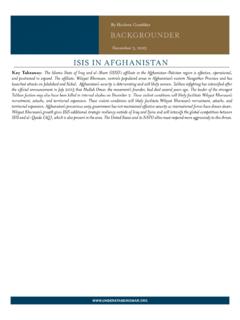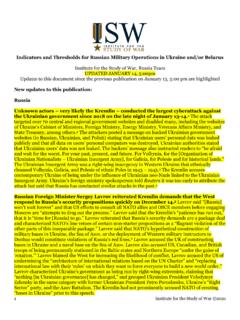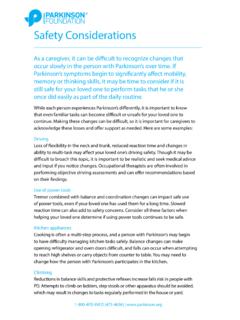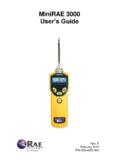Transcription of *SBOJBO4USBUFHZJO4ZSJB
1 *SBOJBO 4 USBUFHZ JO 4 ZSJB#: 8 JMM 'VMUPO KPTFQI IPMMJEBZ 4BN 8 ZFS B KPJOU SFQPSU CZ "&* T $SJUJDBM 5 ISFBUT 1 SPKFDU J/45*565& '03 5)& 456%: 0' 8"3 .BZ All rights reserved. Printed in the United States of America. 2013 by Institute for the Study of War and AEI s Critical Threats ProjectCover Image: Iranian President Mahmoud Ahmadinejad, Syrian President Bashar Al-Assad, and Hezbollah s Sheikh Hassan Nasrallah appear together on a poster in Damascus, Syria. Credit: Inter Press Service News AgencyIranian strategy in syriaA joint Report by AEI s critical threats project & Institute for the Study of WarWill Fulton, Joseph Holliday, & Sam wyerMay 20134 About usAbout the AuthorsWill Fulton is an Analyst and the IRGC Project Team Lead at the Critical Threats Project at the American Enterprise Institute. Joseph Holliday is a Fellow at the Institute for the Study of War. Sam Wyer served as an Iraq Analyst at ISW from September 2012 until February authors would like to thank Kim and Fred Kagan, Jessica Lewis, and Aaron Reese for their useful insights throughout the writing and editorial process, and Maggie Rackl for her expert work on formatting and producing this report.
2 We would also like to thank our technology partners Praescient Analytics and Palantir Technologies for providing us with the means and support to do much of the research and analysis used in our the Institute for the study of WarThe Institute for the Study of War (ISW) is a non-partisan, non-profit, public policy research organization. ISW advances an informed understanding of military affairs through reliable research, trusted analysis, and innovative education. ISW is committed to improving the nation s ability to execute military operations and respond to emerging threats in order to achieve strategic AEI s Critical threats ProjectThe Critical Threats Project of the American Enterprise Institute equips policymakers, opinion leaders, and the military and intelligence communities with detailed and objective open-source analysis of America s current and emerging national security challenges.
3 Through daily monitoring, in-depth studies, graphic presentations, private briefings, and public events, the project is a unique resource for those who need to fully understand the nuance and scale of threats to America s security to effectively develop and execute our technology PartnersPraescient Analytics is a Veteran Owned Small Business based in Alexandria, Virginia. Our aim is to revolutionize how the world understands information by empowering our customers with the latest analytic tools and methodologies. Currently, Praescient provides several critical services to our government and commercial clients: training, embedded analysis, platform integration, and product customization. Palantir Technologies is working to radically change how groups analyze information. We currently offer a suite of software applications for integrating, visualizing and analyzing the world s information.
4 We s u p p o r t m a n y k i n d s of d a t a i n c l u d i n g s t r u c t u r e d , u n s t r u c t u r e d , r e l a t i o n a l , temporal and of ContEntsExecutive Summary ..6 Introduction .. 9 Advisory 10 Top-level Support to the Syrian Army ..10 Intelligence Support ..13 Military Resupply .. 15 Air ..15 Ground ..17 Sea ..18 Paramilitaries and 19 Support to Syrian Shi a Militants in .. 26 Notes .. 28 Appendix: The Assassination of Iranian Quds Force General Hassan Shateri in & GraphicsChart 1: Known Senior Personnel in Iran s Advisory Mission to 14 Map 1: Syria-Iraq Border Crossing Points .. 18 Map 2: Lebanese Hezbollah Areas of Operation .. 21 Map 3: Regime Control and Lines of Communication in 256 ExECutIvE summAryThe Islamic Republic of Iran has conducted an extensive, expensive, and integrated effort to keep President Bashar al-Assad in power as long as possible while setting conditions to retain its ability to use Syrian territory and assets to pursue its regional interests should Assad fall.
5 The Iranian security and intelligence services are advising and assisting the Syrian military in order to preserve Bashar al-Assad s hold on power. These efforts have evolved into an expeditionary training mission using Islamic Revolutionary Guards Corps (IRGC) Ground Forces, Quds Force, intelligence services, and law enforcement forces. The deployment of IRGC Ground Forces to conflict abroad is a notable expansion of Iran s willingness and ability to project military force beyond its has been providing essential military supplies to Assad, primarily by a i r. Opposit ion ga i ns i n Syr ia have i nterd icted many g rou nd resupply routes between Baghdad and Damascus, and the relative paucity of Iranian port-visits in Syria suggests that Iran s sea-lanes to Syria are more symbolic than practical. The air line of communication between Iran and Syria is thus a key vulnerability for Iranian strategy in Syria.
6 Iran would not be able to maintain its current level of support to Assad if this air route were interdicted through a no-fly zone or rebel capture of Syrian is also assisting pro-government shabiha militias, partly to hedge against Assad s fall or the contraction of the regime into Damascus and a coastal Alawite enclave. These militias will become even more dependent on Tehran in such a scenario, allowing Iran to maintain some ability to operate in and project force from Syria. Lebanese Hezbollah began to take on a more direct combat role in Syria as the Assad regime began losing control over Syrian territory in 2012. Hezbollah has supported Assad with a robust, well-trained force whose involvement in the conf lict aligns with Iranian strategic interests as Secretary General Hassan Nasrallah acknowledged on April 30 in Tehran. Hezbollah s commitment is not without limitations, however, because Nasrallah must carefully calibrate his support to Assad with his domestic responsibilities in order to avoid alienating his core constituency in summAryIraqi Shi a militants are also fighting in Syria in support of Assad.
7 Their presence became overt in 2012 with the formation of the Abu al-Fadl al-Abbas Brigade, a pro-government militia that is a conglomerate of Syrian and foreign Shi a fighters, including members of Lebanese Hezbollah and Iraq-based Asa ib Ahl al-Haq and Kata ib Hezbollah. Like other paramilitary forces operating in Syria, these militants escalated their involvement as the conflict descended into civil war. The open participation of Iraqi Shi a militants in Syria is an alarming indicator of the expansion of sectarian conflict throughout the region. The Syrian conf lict has already constrained Iran s inf luence in the Levant, and the fall of the Assad regime would further reduce Tehran s ability to project power. Iran s hedging strategy aims to ensure, however, that it can continue to pursue its vital interests if and when the regime collapses, using parts of Syria as a base as long as the Syrian opposition fails to establish full control over all of Syrian strAtEgy In syrIA | WIll fulton, JosEPh hollIdAy, sAm WyEr | mAy 20139 Iranian training and support to the Syrian state security apparatus is intended to prolong Assad s grip on power.
8 This effort consists of an advisory and assistance mission to support the Assad regime s security forces. Iran has conducted this foreign internal defense mission in Syria using its regular Islamic Revolutionary Guards Corps (IRGC) forces alongside the IRGC Quds Force and other clandestine services, marking a new kind of Iranian expeditionary military strategy. These missions initially supported Assad s counterinsurgency campaign, which attempted to restore state control throughout Syria. As Assad began to lose control over eastern and northern Syria in the summer of 2012, the Iranian advisory and assistance mission continued to reinforce Assad s geographically consolidated grip on central and southern is also hedging against the failure of this strategy by complementing its support for state security institutions with assistance to pro-government militias in order to develop proxies that will survive Assad.
9 This aspect of Iran s approach is congruent with Tehran s longstanding efforts in Lebanon and Iraq, where it also built Shi a militias to ensure that its interests were protected even in the absence of effective or pliable host states. These paramilitary forces have become increasingly important to Iran and the Assad regime as the nature of the conflict has devolved from counterinsurgency to civil war. As Syrian state military capabilities continue to deteriorate, these militias may form the framework for Iran s continued influence and activity in Syria and the region. The Syrian conflict has already constrained Iran s influence in the Levant, and the fall of the Assad regime would further reduce Tehran s ability to project power. Iran s hedging strategy aims to ensure, however, that it can continue to pursue its vital interests if and when the regime collapses, using parts of Syria as a base as long as the Syrian opposition fails to establish full control over all of Syrian territory.
10 This strategy is meant to guarantee that the mostly Alawite remnants of the Assad regime continue to provide support for Iranian activity in the Levant even if an opposition government takes power in Damascus. By encouraging convergence between pro-regime militias and loyalist remnants of the Assad regime by supporting both the official and the paramilitary components of Assad s forces, Iran is working to preserve its short-term interests while laying the foundations for long-term influence and access in the Levant. Few observers doubt Iranian involvement in Syria. The scope and nature of that involvement, however, has been difficult to describe or pinpoint. Iran has once again demonstrated Syria is vital to Iran s strategic interests in the Middle East and has long been Iran s closest state ally. The Assad regime has provided crucial access to Iranian proxies, including Lebanese Hezbollah, Hamas, and Palestinian Islamic Jihad, allowing Iran to move people, weapons, and money to these groups through Syrian territory.















